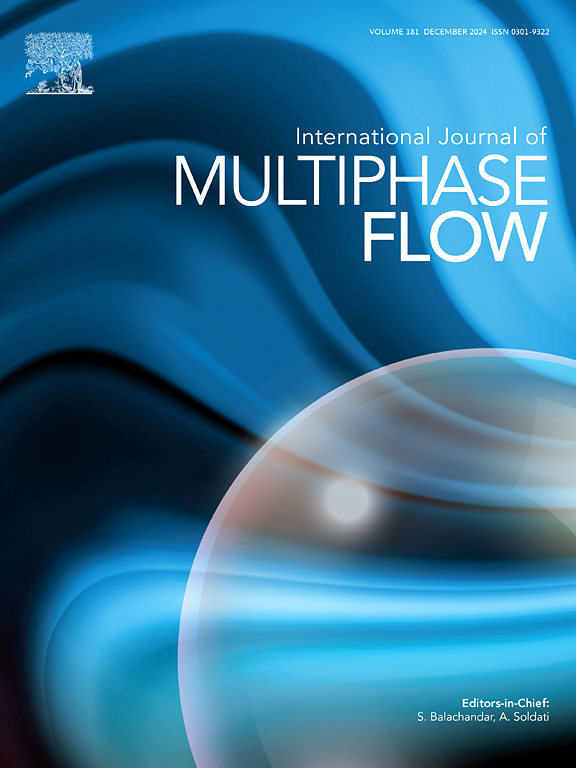On the influence of the periodic boundary conditions on the drag of random particle arrangements in PR-DNS
IF 3.6
2区 工程技术
Q1 MECHANICS
International Journal of Multiphase Flow
Pub Date : 2025-01-25
DOI:10.1016/j.ijmultiphaseflow.2025.105143
引用次数: 0
Abstract
Particle-resolved direct numerical simulation is an accurate tool for studying aspects of particle-laden flows, allowing, for instance, for the accurate estimation of fluid hydrodynamic forces on particles. While periodic boundary conditions are often used to mimic large suspensions of particles, they can introduce spurious effects if the domain size is not sufficiently large. This work investigates the effect of the domain size on the drag forces experienced by particles in random arrangements. Current practice relies on the diminishing spatial autocorrelation of the fluid velocity fluctuations as a measure to prevent periodicity effects. In this study, the impact on the drag force itself is directly monitored. First, the case of particle pair in Stokes flow is considered at varying inter-particle distances and orientations with respect to the mean flow. This provides the “worst-case scenario” for domain size, i.e. very dilute suspensions and low Reynolds numbers. Second, random arrangements of particles are considered with incrementally expanding periodic domain sizes. The spatial autocorrelation of the fluid velocity fluctuations shows inconsistencies for small domain sizes across different realizations. Additionally, the influence of Reynolds number and particle volume fraction on the correct domain size are investigated separately. The effect of the Reynolds number is found to be small and does not significantly contribute to the effect of domain size. On the other hand, particle volume fraction shows an impactful contribution where lower volume fractions require larger domain sizes to minimize the periodicity effects. Finally, recommendations for the required domain size for PR-DNS are presented.

周期边界条件对PR-DNS中随机粒子排列阻力的影响
颗粒分解直接数值模拟是研究颗粒流动方面的精确工具,例如,允许精确估计颗粒上的流体动力力。虽然周期性边界条件通常用于模拟大颗粒悬浮液,但如果域尺寸不够大,它们可能会引入虚假效应。这项工作研究了区域大小对随机排列的粒子所经历的阻力的影响。目前的做法依赖于减小流体速度波动的空间自相关性,作为防止周期性效应的一种措施。在本研究中,直接监测对阻力本身的影响。首先,考虑了斯托克斯流中粒子对相对于平均流在不同粒子间距离和方向下的情况。这就提供了畴大小的“最坏情况”,即非常稀的悬浮液和低雷诺数。其次,考虑粒子的随机排列与增量扩展的周期域尺寸。流体速度波动的空间自相关在不同的实现中显示出小域尺寸的不一致性。此外,还分别研究了雷诺数和颗粒体积分数对正确畴尺寸的影响。发现雷诺数的影响很小,对畴尺寸的影响不显著。另一方面,颗粒体积分数显示出影响的贡献,其中较小的体积分数需要更大的畴尺寸来最小化周期性效应。最后,给出了PR-DNS所需域大小的建议。
本文章由计算机程序翻译,如有差异,请以英文原文为准。
求助全文
约1分钟内获得全文
求助全文
来源期刊
CiteScore
7.30
自引率
10.50%
发文量
244
审稿时长
4 months
期刊介绍:
The International Journal of Multiphase Flow publishes analytical, numerical and experimental articles of lasting interest. The scope of the journal includes all aspects of mass, momentum and energy exchange phenomena among different phases such as occur in disperse flows, gas–liquid and liquid–liquid flows, flows in porous media, boiling, granular flows and others.
The journal publishes full papers, brief communications and conference announcements.

 求助内容:
求助内容: 应助结果提醒方式:
应助结果提醒方式:


